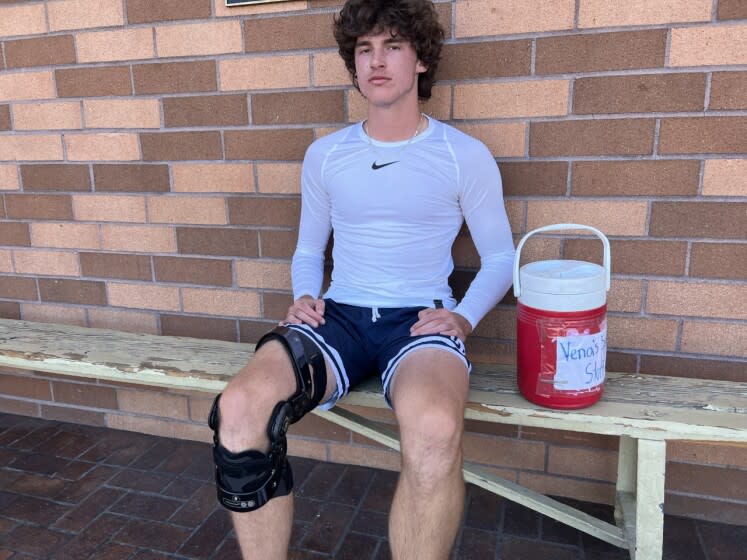Sondheimer: Loyola's Xavier Rice ready for new chapter in comeback story

There are few experiences more devastating for a teenage athlete than a season-ending injury. It happened to quarterback Xavier Rice of Los Angeles Loyola High in the second quarter of the second game last season.
He rolled left and after releasing the ball, his foot got caught in the turf. He was helped off the field. At first, no one believed the injury was serious. He could still walk. He was able to jog on the sideline. He went back in.
A couple of plays later, even though he was wearing a knee brace, the same leg buckled after a high snap. “I heard it pop,” he said of his right knee. “I think I did something the first time and then tore it.”
He had never been injured playing sports, so when he went to the doctor’s office for an MRI exam and was told the result, a torn anterior cruciate ligament, his reaction was understandable.
“I remember vividly when they showed the picture,” he said. “He was going through where everything is supposed to be. ‘This black space is where your ACL is supposed to be. There’s nothing there.’ I remember literally almost fainting when he told me I wouldn’t be able to play for the rest of the season.”
It’s one challenge to deal with the physical ramifications of a season-ending injury, but the psychological challenges are equally difficult. Recovery doesn’t come simply by hoping an injury will heal. There’s much more involved, lessons to be learned and surely bouts of adversity to overcome. But once clearance is given to return, all the hard work, sweat and tears end up being worth it, Rice said.
Good to see Loyola QB Xavier Rice back on the field. Tore ACL in second game last season. Has lots of potential. pic.twitter.com/xT1KqAx4Rj
— eric sondheimer (@latsondheimer) July 8, 2022
“Growing up, I never had an injury keeping me out,” he said. “So it was definitely something new that I had to learn, but as time went on, I realized all I could do was worry about what I could control. It wasn’t going to heal the next day. I had to take it day by day.”
The night he learned he would be sidelined for some ninth months, he cried.
Loyola athletic trainer Tim Moscicki said: “There’s panic. The initial 24, 48 hours is: ‘Why me? Oh my God, my career is over.’ Once you’re able to give them a day or two to calm down and talk the process of surgery and rehabilitation, they have hope.”
Dr. Richard Ferkel, an orthopedic surgeon, said he would never tell an athlete over the phone that an injury was season-ending. It would be in person because the news is almost always "a traumatic event" and he wants to offer comfort and a plan going forward.
Rice’s focus changed to recovery, and his mental state was helped by rooting on the sideline for teammates to succeed during the season. His parents offered positive reinforcement too.
“They knew I wouldn’t hang my head,” he said.
Technology and treatment for an ACL injury have changed dramatically. You can’t see an incision on his right knee because it was arthroscopic surgery. There was a time 30 years ago the knee remained immobilized for six weeks after surgery and large scars would be visible. Nowadays, some patients are riding on a bike the next day and rehabilitation is even happening before the surgery.
Rice spent five months strengthening the knee with light weightlifting and running drills while also using an anti-gravity machine. His weight dropped from 180 pounds to 168 because of inactivity, and he was told not to throw any passes because the surgically repaired knee was on his plant leg. That required patience and discipline.
This summer, Rice has worn a new ACL brace on his right knee while participating in seven-on-seven passing competitions. His weight has increased to 190 pounds. He has been cleared for full contact for his senior season.
“The doctor said most people after coming back from an ACL injury are actually stronger,” Rice said.
The next big step will be the mental barrier of taking his first hit and not panicking if there’s any pain in his knee. He watched an interview done by Cincinnati Bengals quarterback Joe Burrow, who had his own torn ACL injury, and Burrow said the knee got stronger week after week.
Ferkel said the comeback requires patience. Coming back too soon can lead to another rupture. "It's a tremendous amount of work to get back, and the kid has to be totally committed to wanting to get back," he said.
Rice is not the only player coming back from a season-ending injury. Bellflower St. John Bosco linebacker Kyngstonn Viliamu-Asa sat out his sophomore season after suffering a torn ACL in the final game of the COVID-19 spring season in 2021. He is back this summer looking stronger than ever.
“I learned patience,” he said. "I learned how to overcome adversity. It makes me appreciate the game a lot more.”
Got some work in at the South County passing tournament yesterday. Looking forward to camp! pic.twitter.com/jVElVcqAoO
— Jaxon Hughes (@Jaxon_Hughes_) July 18, 2022
Wide receiver Jaxon Hughes of Anaheim Servite broke his ankle last season and missed his team reaching the Southern Section Division 1 final. “It sucked not being out there, but I learned a lot,” he said.
Quarterback Darius Curry of Long Beach Poly suffered an ACL injury midway through last season. Now he’s back and a leading candidate to take over starting duties in his junior season.
Comeback stories are great to tell, especially because of the commitment required to make it back. Rice and others coming back from season-ending injuries in 2021 have earned respect and admiration for the hard road they had to travel.
This story originally appeared in Los Angeles Times.

